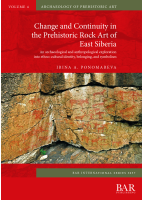Description
The volume covers a huge region of East Siberia, considering prehistoric ethno-cultural and social processes through the development of rock art styles and traditions. This study addresses the questions of why rock art is created, why specific styles and traditions emerge and why changes in rock art occur. These questions are explored through anthropological perspectives on ethnicity, identity, and symbolism. A reader will find a comprehensive overview of the developments of rock art research in Siberia as well as detailed accounts of the regional archaeology in the Bronze/Iron ages, the Neolithic, and partially the Late Paleolithic. Importantly, this study is primarily fieldwork-based, presenting information on 108 rock art sites in Yakutia and Trans-Baikal. This work makes a major contribution to Siberian and global rock art research and suggests new directions for future rock art research.
AUTHOR
Irina A. Ponomareva has a degree in archaeology from Saint-Petersburg State University, Russia, and holds a PhD from Griffith University, Australia. Her research interests include rock art and archaeology of Central and North Asia, ethnography of Siberian peoples, cultural anthropology, and Australian Aboriginal archaeology. She is currently a Resident Adjunct at Griffith University also working as an archaeologist with Aboriginal communities in QLD, Australia.
REVIEWS
‘Siberian rock art is still underrepresented in international scholarship and Ponomareva’s book will be a significant contribution to developing knowledge and interest in the rock art of this part of the world.’ Professor Andrzej Rozwadowski, Adam Mickiewicz University, Poznań
‘This work is incredibly ambitious: it covers a huge geographic area, yet provides a huge amount of detail on the current state of research for both rock art and archaeology in eastern Siberia. Non-Russian speakers will immediately find it invaluable for the sheer scale of the research overview, while those interested in the region’s rock art will benefit from the publication of the 108 rock art sites (both re-recorded and newly identified).’ Dr Rebecca O'Sullivan, University of Bonn











